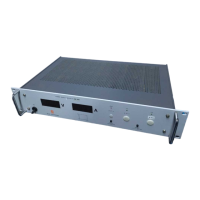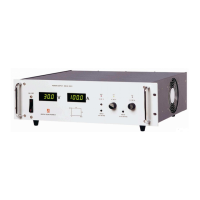Do you have a question about the Delta Elektronika PSC-232 module and is the answer not in the manual?
| Output Voltage | 0-32 VDC |
|---|---|
| Voltage Regulation | < 0.01% + 2 mV |
| Safety Standards | EN 61010-1 |
| EMC Standards | EN 61326-1 |
| Category | Power Supply |
| Operating Temperature | 0-50 °C |
| Storage Temperature | -20 to 70 °C |
| Relative Humidity | non-condensing |
| Cooling | Forced air |
| Interface | Analog |
Details range, power consumption, and hold-up time for the PSC.
Specifies EMC emission and immunity standards met by the PSC.
Describes the isolation voltage ratings for different PSC connections.
Specifies the operating and storage ambient temperature ranges for the PSC.
Details setting, calibration, and specifications of the PSC's analog outputs.
Outlines connection and cable length restrictions for the IEEE 488 bus.
Explains how to set the 5-bit binary address using switches A1 to A5.
Enables SRQ at power-on and service request capability in DPL mode.
Selects PSC 44M emulation mode or SCPI language on PSC-488 models.
Selects RS232 or GPIB mode for PSC-488 models.
Details baudrate settings for PSC-232 models using switches A7 and A8.
Lists factory default settings for PSC-488 and PSC-232 models.
Details RS232 connector types, pin assignments, and communication parameters.
Provides pinout details for the 15-pin connector, including PSC In/Output descriptions.
Lists common ASCII symbols with their decimal, hexadecimal, and code display values.
Summarizes data types like Digit, Hexadecimal, Binary, and String with their representations.
Explains Boolean parameters and their possible values (True/False, ON/OFF, 1/0).
Defines numerical data formats like NR1 (signed integer) and NR2 (floating point).
Steps for installing the PSC-488 module for rail or rack mounting.
Steps for installing the PSC-488 card set inside a power supply.
Steps for installing the PSC-232 module for rail or rack mounting.
Steps for installing PSC-232 card sets (P146 or P148) inside a power supply.
Procedure for configuring the PSC using LabView software, setting address and ranges.
Procedure to calibrate the voltage DAC offset using a digital mV meter and software.
Procedure to calibrate the voltage DAC gain using a digital voltage meter and software.
Procedure to calibrate the voltage ADC offset using a digital voltage meter and software.
Procedure to calibrate the voltage ADC gain using a digital voltage meter and software.
Procedure to calibrate the current DAC offset using a shunt and DVM.
Procedure to calibrate the current DAC gain using a shunt and DVM.
Procedure to calibrate the current ADC offset using a digital ampere meter and software.
Procedure to calibrate the current ADC gain using a digital ampere meter and software.
Procedure to change the instrument's identification string, including model and custom details.
Lists mnemonic commands for DPL, such as SA, SB, FU, FI, U, ERR?, ID?, MA?, MB?, SCPI.
Describes how the PSC-488 reflects power supply condition and reports events via the Status Byte Register.
Explains the Service Request Enable Command and its effect on the Service Request Enable Register.
Provides a diagram illustrating the interrelations of various registers like Status Byte, Event Status, and Device Status.
Explains the Read Status Byte Query, its returned values, and how RQS bit is cleared.
Describes the Clear Status Command which clears device status structures and sets operational states.
Explains the Standard Event Status Enable Command and its role in summarizing events in the Status Byte Register.
Details the *ESR? query, which causes the Standard Event Status Register to be cleared and reports errors.
Defines the Device Status Enable command and its register, which summarizes device events into the Status Byte Register.
Explains the Device event Status Register query, capturing condition transitions and clearing the Device Status Enable Register.
Describes the Device Status Condition register which reflects the power supply's status in decimal and binary format.
Explains the Device Extended status Enable command for summarizing Device Extended status Register events.
Details the Device Extended status Register which contains power supply extended status changes.
Describes the Device Extended status Condition register that reflects power-supply status.
Explains the Operation Complete Command for synchronization between controller and devices.
Describes the *RST command which resets device dependent functions, excluding configuration and calibration data.
Explains the Self-Test Query that executes an internal self-test and reports errors.
Describes the Wait-to-Continue Command used for forcing sequential execution after overlapped commands.
Explains how to save settings and calibration data in non-volatile memory, with optional password protection.
Describes how to recall settings and calibration data previously stored with the *SAV command.
Explains the Identification Query used to identify the PSC within a system.
Commands to set maximum voltage and current ranges for the power supply.
Commands for calibrating zero-offset and full-scale for current programming and monitoring.
Commands for calibrating zero-offset and full-scale for voltage programming and monitoring.
Commands for setting and managing the password for configuration and saving.
Commands to control output functions, front panel lock, and remote/local modes.
Commands to set source voltage/current and measure output voltage/current.
Commands for channel selection, help, and querying digital input/status.
Command to change the custom string of the instrument's identity.
Indicates a syntax or semantic error detected by the instrument.
Indicates a syntactically valid message that cannot be executed due to device-specific conditions.
Indicates the PSC-488 could not properly complete some device-specific operations.
Occurs when the Message Exchange Protocol is violated, e.g., incorrect query response handling.











